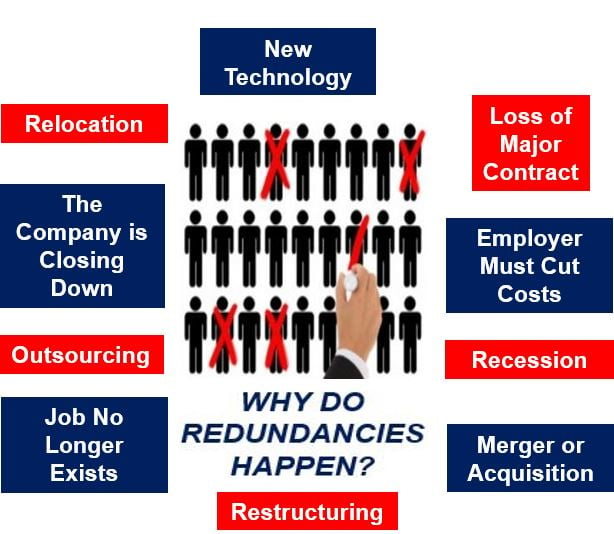What Happens to Redundancy If Company Goes Bust? A Guide to Your Rights
What Happens to Redundancy If Company Goes Bust? A Guide to Your Rights
Blog Article
Exploring the Interaction In Between Firm Redundancy and Organizational Versatility for Future Development
In the dynamic landscape of today's company world, the detailed connection between business redundancy and organizational versatility arises as a vital variable for sustained growth and success. Companies typically deal with the obstacle of striking a fragile equilibrium in between keeping a degree of redundancy to mitigate risks and fostering adaptability to respond swiftly to the ever-evolving market demands.
Relevance of Firm Redundancy
Firm redundancy is an essential element that enhances organizational resilience and reduces operational risks. By incorporating redundancy steps within the organizational framework, companies can better endure unanticipated disturbances and variations in the business environment. Redundancy works as a strategic barrier, permitting firms to adapt and react successfully to unforeseen difficulties without compromising important operations.
One trick facet of the significance of firm redundancy is its duty in making certain continuity during times of crisis. When confronted with unexpected modifications or emergencies, repetitive systems, sources, or personnel can action in to keep critical features and stop extensive disruptions. This connection not just safeguards the company's credibility and customer trust but also decreases economic losses and functional downtime.

Methods for Organizational Flexibility

Developing adaptable organizational frameworks that permit for fast adjustments to market dynamics and customer demands is crucial for remaining competitive in a rapidly evolving setting. By proactively identifying possible disturbances and chances, organizations can proactively flourish and adapt in an ever-changing organization landscape.
Balancing Redundancy and Adaptability
Attaining an unified balance between functional redundancy and organizational flexibility is vital in navigating the intricacies of a dynamic organization atmosphere. Redundancy within a company supplies a safety and security internet, making certain continuity and stability in procedures. Nevertheless, an excess of redundancy can bring about ineffectiveness and hinder versatility to changing market conditions. On the various other hand, organizational versatility allows firms here to react quickly to exterior disruptions and confiscate new chances. Striking the right balance in between redundancy and adaptability is a fragile process that needs a deep understanding of the organization's objectives, industry characteristics, and risk resistance.
To accomplish this balance, firms require to carry out normal analyses of their procedures to recognize areas where redundancy is essential for danger mitigation and where versatility can drive advancement and growth. Executing adaptable frameworks, cultivating a society of constant discovering and enhancement, and motivating open communication across all degrees of the company are crucial approaches to balance redundancy and versatility efficiently. By aligning these two critical components, firms can position themselves for sustainable development and success in an ever-changing organization landscape.
Study on Adaptation Success
In analyzing instances of effective organizational adjustment, it comes to be obvious that the interplay in between functional redundancy and adaptability is a specifying aspect in forming resilient organizations. One engaging study is that of Netflix. At first a DVD rental service, Netflix showed amazing adaptability by transitioning right into a streaming platform when digitalization disrupted the market. By purposefully buying technology and content production, Netflix not only prospered but made it through in a quickly developing market. An additional standout example is Amazon. Beginning as an online book shop, Amazon continuously adapted browse this site its organization model, increasing into diverse fields such as cloud computing and fabricated intelligence. This adaptability allowed Amazon to stay in advance of rivals and meet transforming consumer demands. Finally, Adobe offers a significant picture of effective adjustment. The company moved from marketing software licenses to a subscription-based design, making certain recurring profits streams and boosted consumer engagement. These situation researches emphasize the significance of operational redundancy combined with business flexibility in fostering lasting development and competitiveness.
Structure Strength for Future Development
Building durability for future growth calls for a tactical placement of functional processes with market characteristics and emerging patterns. Companies need to adapt to transforming environments by cultivating a culture of adaptability, advancement, and continuous enhancement.
Furthermore, cultivating strong partnerships with stakeholders, such as clients, employees, vendors, and the area, is crucial for keeping and weathering uncertainties trust and assistance during unstable times. Effective interaction and openness play an important duty in building strength, as they help promote and align assumptions collaboration in navigating unpredictabilities.
Additionally, companies need to focus on understanding and advancement campaigns to upskill employees and furnish them with the necessary devices to adapt to altering conditions. By investing in their workforce, firms can enhance their versatility and agility, eventually reinforcing their durability for lasting future growth.
Verdict

In the dynamic landscape of today's service globe, the elaborate partnership between firm redundancy and organizational flexibility emerges as a vital element for continual growth and success. Business usually face the difficulty of striking a delicate balance in between keeping a level of redundancy to minimize risks and cultivating adaptability to respond promptly to the ever-evolving market demands.To attain this balance, business need to conduct normal analyses of their operations to determine locations where redundancy is essential for risk reduction and where flexibility can drive innovation and growth.In final thought, the interaction between business redundancy and business flexibility is important for future development. Structure resilience through a combination of redundancy and adaptability will make sure that business are prepared for the obstacles of the future.
Report this page